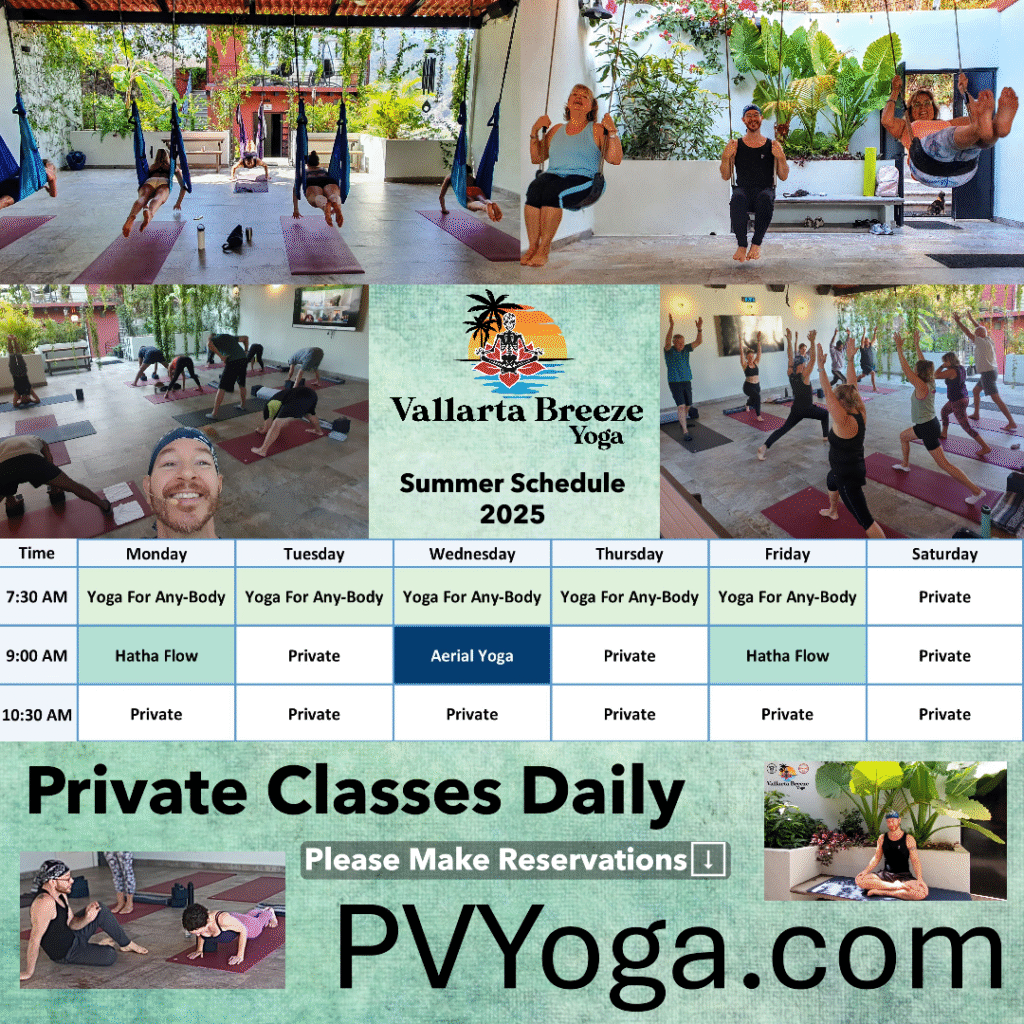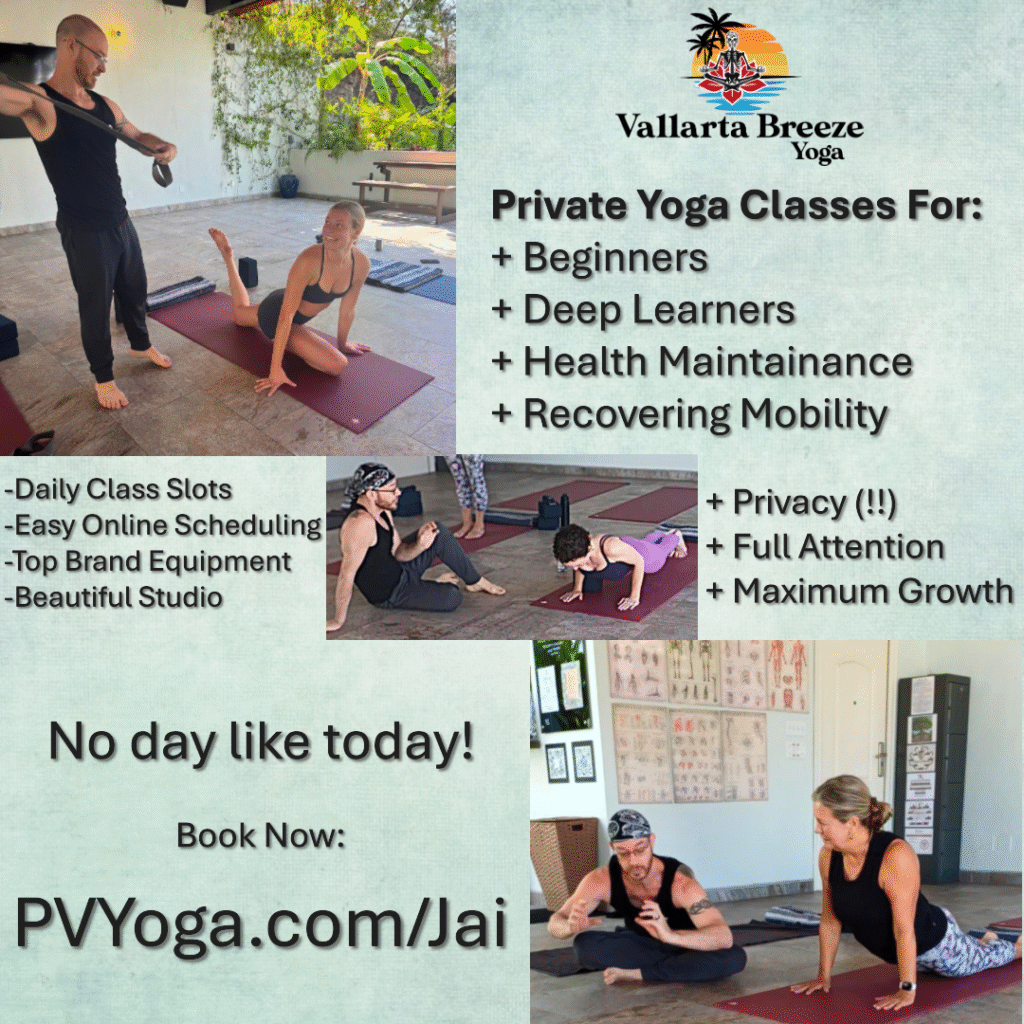Cow Face Pose (Gomukhasana)
Cow Face Pose, or Gomukhasana, derives its name from the Sanskrit words “Go” (cow) and “Mukha” (face). The pose’s distinctive seated shape—with crossed legs resembling a cow’s mouth and arms that evoke the imagery of ears—offers a unique blend of physical stretching, energetic balance, and introspection. Over centuries, this posture has been refined in the traditional hatha yoga lineage, embodying both practical and symbolic aspects of yoga. This is a staple pose at the Vallarta Breeze Yoga Puerto Vallarta Yoga Studio.
Historical Origins and Cultural Significance
Ancient Roots
While precise historical documentation of every asana is rare, traditional texts such as the Hatha Yoga Pradipika and Gheranda Samhita have long emphasized the integration of postures with breath and meditation. Gomukhasana is believed to have evolved as part of a sequence designed for deep relaxation and focused energy flow. Ancient yogis practiced these seated postures not only to cultivate flexibility but also to prepare the body for prolonged meditation—a practice observed in remote Himalayan caves and sacred ashrams.
Cultural Vibrancy
In Indian culture, the cow is revered as a symbol of abundance, fertility, and unconditional generosity. This spiritual symbolism is interwoven with the practice of Gomukhasana. By emulating the gentle, nurturing features of a cow’s face, practitioners engage with a posture that transcends physical exercise and enters the realm of mindful reflection. Artistic depictions and temple carvings from ancient India often reflect seated postures similar to Gomukhasana, suggesting its long-standing integration into both the cultural and spiritual landscapes.
Anatomical and Energetic Overview
Anatomical Benefits
Gomukhasana is a multi-dimensional stretch that benefits various parts of the body:
- Hips and Thighs:
Deeply stretches the gluteal muscles, hip adductors, quadriceps, and fascia around the thighs. - Shoulders and Arms:
Opens the shoulder joints while stretching the triceps, latissimus dorsi, and muscles around the scapula. This detailed engagement helps improve range of motion and correct postural imbalance. - Spinal Alignment:
Encourages an upright spine and releases tension in the thoracic and cervical regions, reinforcing the muscles that support proper alignment. - Internal Organ Stimulation:
Gentle compression in the hip and lower back regions helps stimulate the kidneys and reproductive organs, supporting internal energy circulation.
Energetic Benefits
- Chakra Balancing:
Gomukhasana is particularly effective for harmonizing the heart chakra (Anahata), fostering emotional balance and compassion. - Grounding:
The seated nature and stable leg positioning create a grounding influence, perfect for cultivating mental clarity and a calm state of being. - Mindful Integration:
When practiced with focused breathing and bandha activation, the pose encourages a mindful union of body, breath, and spirit.
Detailed Benefits of Cow Face Pose (Gomukhasana)
| Aspect | Description |
|---|---|
| Physical Stretch | Deeply engages hips, thighs, shoulders, armpits, and triceps—ideal for relieving muscular tension accumulated from daily stressors. |
| Postural Improvement | Strengthens back muscles and encourages spinal alignment, contributing to better overall posture. |
| Organ Stimulation | The gentle compression and stretch stimulate kidneys and reproductive organs, possibly aiding in internal detoxification and energy flow. |
| Energetic Alignment | Harmonizes energy by balancing the heart chakra, lending emotional stability and fostering a sense of centered calm. |
| Mindful Discipline | Integrating breath practices, dristi, and mudras enhances concentration and deepens meditation, producing a holistic mind-body union. |
Contraindications
Before practicing Cow Face Pose, both students and teachers should take note of these contraindications and modify accordingly:
- Joint Concerns:
Avoid if you have severe injuries in the knees, hips, or shoulders. - Neck Issues:
Serious neck problems may be exacerbated in this posture. - Inflammation:
Active inflammation in the knees or hips calls for caution or alternative postural adjustments.
It is advisable for teachers to conduct thorough assessments and provide modifications, and for practitioners to consult healthcare professionals if unsure about practicing safely.
Step-by-Step Practice Guide | Cow Face Pose (Gomukhasana)
1. Starting Position
- Seated Base:
Sit on the floor with your legs extended. Ground yourself in the present moment with a tall, straight spine.
2. Entering the Pose
- Bend the Knees:
Bring your knees toward your chest so your feet rest on the floor. - Leg Arrangement:
- Left Leg: Slide your left foot underneath your right knee, positioning it to the outer side of your right hip.
- Right Leg: Cross your right leg over your left, stacking your right knee directly atop your left knee so that the right foot falls to the outside of your left hip.
3. Arm Position
- Right Arm Action:
Raise your right arm toward the ceiling, bend the elbow, and allow your right hand to cascade down your back. - Left Arm Action:
Reach your left arm behind you and attempt to clasp your right hand. If your hands do not meet, employ a strap, towel, or yoga belt to bridge the distance without straining.
4. Dristi (Gaze)
- Softly fix your gaze on the tip of your nose (Nasagra Drishti) or gently close your eyes to heighten the internal focus, fostering a meditative quality.
5. Bandhas and Mudras
- Engage Mula Bandha:
Activate the root lock to stabilize your practice and support the energetic fluidity. This subtle tightening of the pelvic floor enhances posture and energy flow. - Integrate Chin Mudra:
With your free hand, form Chin Mudra (touching the thumb to the index finger) while resting your hand on your knee, channeling concentration and balancing pranic energy.
6. Holding the Pose
- Maintain Alignment:
Keep your spine elongated and chest lifted. Ensure that your knees remain directly stacked, providing stability to the lower body. - Breathing:
Breathe deeply and evenly. Hold the posture for 30 seconds to 1 minute, listening closely to your body’s signals.
7. Exiting and Repeating
- Release Safely:
Gently unclasp your hands and straighten your legs. - Alternate Sides:
For a balanced practice, repeat the sequence on the opposite side, reversing the stacking of the legs and arm positions accordingly.
8. Counter Pose
- Seated Forward Bend (Paschimottanasana):
Follow with a gentle forward bend to release any lingering tension in the hips and back, rebalancing the body after the deep stretch.
Pro Tips for Enhancing Your Practice
- Utilize Props:
If shoulder tightness prevents your hands from meeting comfortably, a strap or towel is a great prop that can assist without straining. - Mindful Alignment:
Pay close attention to the stacking of your knees and the positioning of your hips. A folded blanket under your hips may provide extra support if needed. The arm position can force the scapula to pull too far from the ribcage, if you find it uncomfortable, use eagle arms or another variation instead. - Deep, Even Breaths:
Focus on maintaining steady, deep breaths throughout the practice. This not only deepens the stretch but also enhances the meditative quality of the posture. - Cultural Awareness:
Embrace the historical and cultural roots of Gomukhasana by meditating on the symbolism of the cow in Indian tradition—nourishment, stability, and gentle strength. This awareness can add depth and intention to your practice.
Final Thoughts
Cow Face Pose (Gomukhasana) is a doorway into a vibrant tradition of mindful movement and spiritual symbolism. With its ancient roots in hatha yoga and its rich cultural significance in Indian spirituality, this pose invites practitioners to explore a holistic integration of body, mind, and energy. For students, it offers a chance to deepen flexibility, improve posture, and awaken inner balance; for teachers, it provides a versatile tool to guide and inspire practitioners of all levels.
Whether you’re seeking a comprehensive stretch or a meditative pause in your day, Gomukhasana bridges the gap between physical alignment and energetic harmony. Delve deeper into your practice by exploring complementary poses, meditation techniques, or pranayama, and allow the spirit of this revered pose to guide you on the journey toward self-discovery and holistic well-being.
Embrace this ancient posture as a living tradition—a testament to yoga’s timeless ability to unite the physical, energetic, and cultural dimensions of our lives.
Continue your growth with the Vallarta Breeze Yoga Puerto Vallarta Yoga Studio!
Whether you’re looking to dive deeper into the physical practice of yoga, The Vedas, Upanishads, Yoga Sutras, or would like to explore our blog, we have a wealth of information available for you! Better yet, join us here in the Vallarta Breeze Yoga Puerto Vallarta Yoga studio, or practice with us online! we’re excited to continue this journey with you. See you on the mat!



